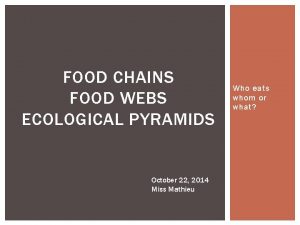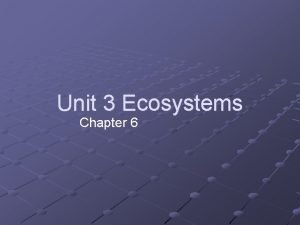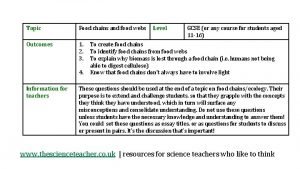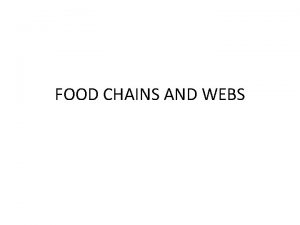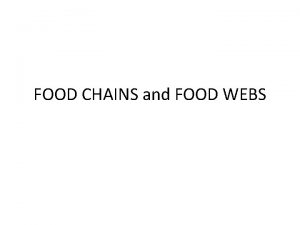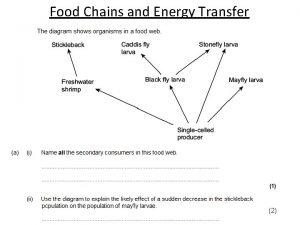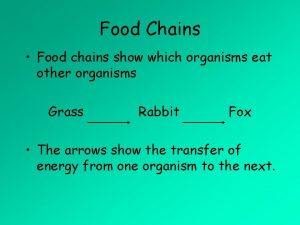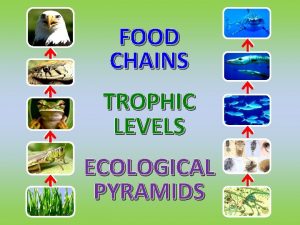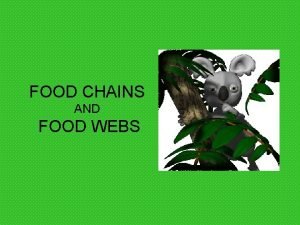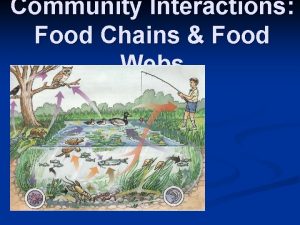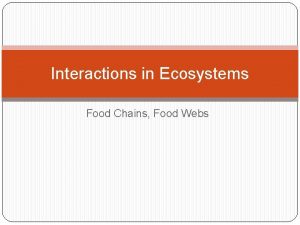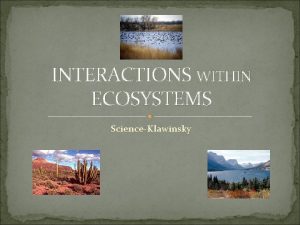Interactions in our Environment Food Chains and Food












- Slides: 12

Interactions in our Environment Food Chains and Food Webs

Food Chains and Food Webs �Learning Goals: Describe a food chain and the effect of losing a part of that chain. �Success Criteria: I can describe a food chain/web and discuss what happens when one part of the food web is lost.

Where do we get our Energy? �All energy in ecosystems originate with the sun. As we learned last lesson, plants absorb energy and turn it into foods such as sugars and starches. �Animals eat the plants and the energy is transferred. �Carnivores and omnivores eat those animals and energy is again transferred.

A food chain is created. . sun grains chicken Chicken dinner Food Chain (def): A sequence that shows how energy and nutrients are transferred from one organism to another in an ecosystem.

Food Chains �The number of “links” in a food chain can vary, but it always starts with a producer and ends with a consumer. Blueberry bush bear 2 links 5 links: dandelion aphid ladybug robin hawk

Food Webs �In real ecosystems, food chains are not that simple. �Producers (plants) are usually eaten by many different consumers (animals) which in turn can be eaten by many other animals. �Food Web (def): A model that shows how food chains in an ecosystem are connected.

A more realistic Food Web

Your Turn. . �In your group, create a food web. �Work together to think of as many plants and animals as possible that will be part of your web. Animals/plants must be realistic and links must be accurate (e. g. A bear does not eat a lion!) �You must identify your ecosystem! �Your group will have 8 minutes to make your web. Be ready to present. �Which group will have the most connections?

Changes in Food Chains/Webs �What happens when one species is eliminated from the web? (Discuss as a class and run Gizmos simulation)

Changes in Food Chains/Webs �If one species is eliminated (e. g. goes extinct) it affects the other species in that food web. �Sometime other species will die or they may find an alternate source of food. �When any part of a food web is changed the flow of energy is affected in a food web. We will be studying energy flows next.

Let’s Review Food Webs and Introduce Energy Flows �Food Chains, Food Webs and Energy Pyramids in Ecosystems �Food chains/webs show energy moves from one organism to another but they do not show the energy is used.

Energy Flow in an Ecosystem � 1. Work with a partner to find the important information and make jot notes about the information on pages 132 -134. (Hint: divide the information into headings, following the text and use diagrams to help you illustrate and understand) � 2. Go to Gizmos in the Hub and complete the quiz for Food Chains
 Awareness of ourselves and our environment is:
Awareness of ourselves and our environment is: Awareness of ourselves and our environment
Awareness of ourselves and our environment Awareness of ourselves and our environment
Awareness of ourselves and our environment Our awareness of ourselves and our environment.
Our awareness of ourselves and our environment. Producers of a food chain
Producers of a food chain Section 4 food chains and food webs
Section 4 food chains and food webs Food chains, food webs and ecological pyramids
Food chains, food webs and ecological pyramids Why does organism eat another organism
Why does organism eat another organism Desert ecosystem producers
Desert ecosystem producers Food web and food chain
Food web and food chain How many food chains are there in the food web
How many food chains are there in the food web Interactions in the environment grade 7
Interactions in the environment grade 7 Energy flow trophic levels
Energy flow trophic levels






